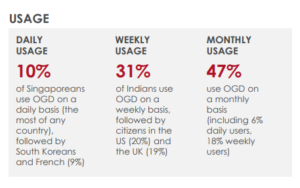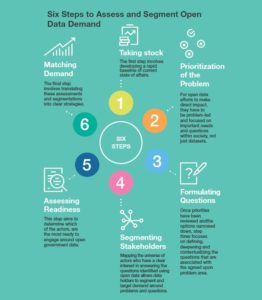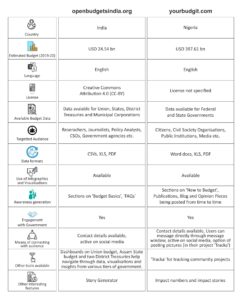What is open data? As defined by opendefition.org, “Open data and content can be freely used, modified, and shared by anyone for any purpose”. Open data has been talked about a lot in the recent years. Across the globe, demand for open data is increasing rapidly. Moreover when it comes to public finance, availability of data in open formats becomes all the more critical for strengthening the accountability ecosystem around government finances.
Growing demand for open data
In recent years, there has been a visible increase in the demand for availability of Open Government Data (OGD) in public domain. Owing to democratic pressure, many governments around the world are trying hard to meet citizens’ requirement in this sphere. In a survey based on 1000 respondents (100 respondents each from 10 countries) on the usage of OGD, it was observed that:

Despite growing interest, currently, awareness on publishing reliable OGD to meet requirements of different stakeholders is low. In the same survey, 31% of the respondents had pointed out lack of availability of relevant data as one of the main barriers. Hence, it is very important to have a clear understanding of the demand of different stakeholders/users in order to provide relevant information in public domain or to create accessible and useful open data portals. A recent report clearly lists down six steps involved in assessing and segmenting open data demand:

When it comes to public finance and more specifically, government budgets, the task becomes even more difficult. To provide easy to comprehend budget information for different tiers of governments in a timely manner requires a lot of hard work. Various government Budget Portals have been created and are available in public domain with an aim to provide budget data in an open data format; but their success is still questionable.
Bridging the gap: Role of Civil Society Organisations in bringing government budgets closer to people
The Open Budget Survey (OBS) of 2017 released by the International Budget Partnership (IBP) indicates that 89 out of 115 surveyed countries fail to provide adequate government budget information in public domain. Not only this, the survey shows a modest decline in average global budget transparency scores, from 45 in 2015 to 43 in 2017.
Hence, it becomes even more important for Non-Government Organisations / Civil Society Organisations / other agencies to play an active role in this sphere. According to a report, ‘Although 79 out of the 115 governments surveyed have an open government data portal, often the most complete data is published on a source other than the official open data portal. In such countries, the majority of the most comprehensive datasets (61%) are published by other government agencies’.
Apart from ensuring data availability in public domain, another challenge for them is to build citizens' capacity to understand and use budget information. Lack of awareness (as per 50% respondent of the survey) is one of the major barriers that prevent effective use of information available online. Citizens/ users are not are fully aware about the potential use and benefits of the available information. Hence, apart from providing data, it is critical that data portals should also provide basic information about government budgetary concepts and processes and how the information can be effectively used.
A Quick glance at some open budget data portals
It was interesting to go through some of the budget portals available online. The portals that were assessed are Open Budgets India - OBI (India) and yourbudgit - Budgit (Nigeria). The comparison has been made to understand their strategies and features, with due consideration that both countries are very different in size both geographically and demographically.
Estimated budget of Nigeria, for the current financial year, is close to USD 24.55 billion whereas the estimated budget of India is close to USD 397.60 billion, i.e. almost 16 times more than Nigeria. Hence, OBI has much vast budget data to deal with in comparison to Nigeria. Sharing below a quick comparison:

The table above clearly indicates that both the portals aim at providing and presenting budget data in open formats to boost fiscal transparency in the country. Their forte lies in being a one stop point for budget data for Federal/Union government, State governments and Local governments. However, both portals have their own strengths and weaknesses. We try to compare the two portals side by side using some parameters as below:
Available Budget Data: On comparing both, it would not be wrong to label OBI as more ‘Transparency’ oriented portal and Budgit as more ‘Accountability’ oriented portal. OBI’s strength lies in the huge data it provides. Users can explore close to 10.6k datasets from 509 budget sources covering Union level, 29 States, 10 Districts and 61 Municipal Corporations. On the other hand, Budgit provides data at Federal level and for 36 States. In addition, both the portals also provide sectoral budget data, hence, making it even more accessible and locally relevant.
Awareness Generation: Portals are not just data providers but knowledge creators as well. In Budgit, section on ‘New to Budget’ provides basic information about government budget and budget data. It also shares various publications, opinion pieces, media pieces, blogs, impact stories etc. from time to time. On the other hand, in OBI, sections like ‘Budget Basics’, ‘FAQs’ etc. are helping users build their knowledge about public finance.
Data Formats and Use of Infographics: OBI is conforming to Creative Commons Attribution 4.0 (CC-BY) license, whereas Budgit does not mention anywhere in the portal about the license they conform to. Also, OBI provides data in CSVs, XLs and PDFs whereas most of the data in Budgit is available in PDFs and only a few documents are in XLs and Word Docs. But it is evident that efforts have been made, by both the portals, to provide data interestingly using visualisations and infographics.
Tools and Features: OBI maintains ‘Dashboard’ on Union budget, Assam State budget and two district treasuries. These dashboards help navigating through data, visualisations and provide insights for different tiers of government. On the other hand, innovative tools like ‘Tracka’, in Budgit, help in engaging citizens in the implementation of government projects in their community and to be a part of the change they want to see.
These portals are working towards bridging the gap between citizens and governments and in the process, enabling citizens to question governments in case of any gap. Another important aspect that can’t be missed is that they are unceasingly trying hard to involve governments (at various levels) in the process as part of their advocacy efforts. Developing and maintaining dashboards (in OBI) for State governments and District Treasuries is an achievement in that direction. Moreover, both the portals are providing institutional support to government departments and agencies from time to time.
Though it is overwhelming to see that lot of efforts are being made to bring budgets closer to people, there is still a long way to go. Till the time government departments are not sensitize enough to produce budget documents in standard formats/machine readable formats (like Open Document Formats for Spreadsheets (ODF) or Excel (XLS) etc.), it is going to be challenging for online portals to present the data in an open standardized format. The focus in this case should be on raising standard of transparency and accountability in government by continuously engaging with them.
It is equally important that more and more citizens become aware of the importance and use of budget information so that the demand for such data increases. Also, citizens should hold their government accountable for using public funds effectively and efficiently and these portals serve as important medium to achieve this end. Hence, role of these portals is not only important but challenging and their continuous endeavor should be towards striking the right balance on both sides with an aim to improve transparency and accountability in the domain of public finance.
The views expressed in this piece are those of the author, and don’t necessarily reflect the position of CBGA. You can reach Shuchita Rawal at
sh******@cb*******.org
.


 24 May 2019
24 May 2019